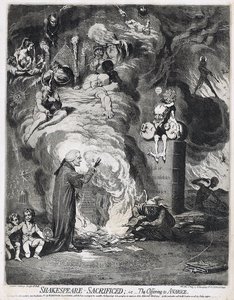Shakespeare Sacrificed; or The Offering to Avarice.
Only £275.00
Size 38cm x 23cm
Originally published by Hannah Humphrey etched by James Gillray from 'The Genuine Works of James Gillray, engraved by himself. Thomas McLean edition on heavy rag-paper from the original copper plates printed 1830.
There are at least two major targets in Gillray's Shakespeare Sacrificed: the first is the publisher, John Boydell and the second, the Royal Academy. In 1786, Boydell and a group of friends came up with the idea of an illustrated edition of Shakespeare. Boydell commissioned many of the best-known artists working in England at the time to paint scenes from Shakespeare which would then be shown at a special Shakespeare Gallery in London. Artists included James Barry, Henry Fuseli, Angelica Kauffman, James Northcote, John Opie, Joshua Reynolds, George Romney, Benjamin West, and others. Engravings, based on the paintings, were also commissioned to be included in the edition of Shakespeare, in a collected folio of prints, and sold separately as individual prints.
Boydell had high hopes for the venture. As a promoter of the arts, he hoped that it would stimulate a new school of British history painting, based appropriately enough on Britain's greatest playwright. As a businessman, however, he also saw an opportunity for several sources of revenue: from attendance at the gallery, from subscriptions to the edition of Shakespeare, from the sale of a folio collection of the prints, and from the sale of individual prints.
Gillray, however, saw the whole effort as a monumental mistake, a deal with the devil that obscured Shakespeare's true significance, and foolishly sacrificed his plays to the interests of fame and greed. Indeed, the venture did ultimately fail, and Boydell was nearly bankrupt by it. Gillray's other target is the Royal Academy with its privileged membership which allowed a select group of painters to show their works at the Great Exhibition Hall but refused that privilege to engravers. Around the hall was the Greek text that is seen in the magic circle at Boydell's feet. It can be translated as "Let no stranger to the muses enter here." A young boy with a painter's palette who kneels safely within the circle pushes away another boy with an engraver's burin. Both, however, are strikingly poor and ragged compared with the richly robed Alderman Boydell. The print includes figures from various Shakespearean scenes, most of which have identifiable sources among the paintings and engravings commissioned by Boydell. (www.james-gillray.org)
 View Account
View Account
